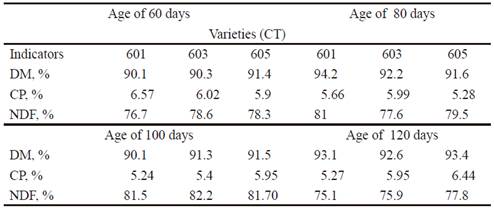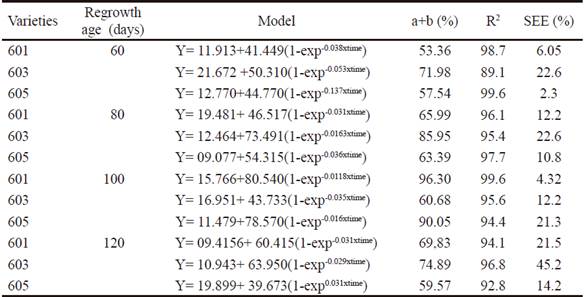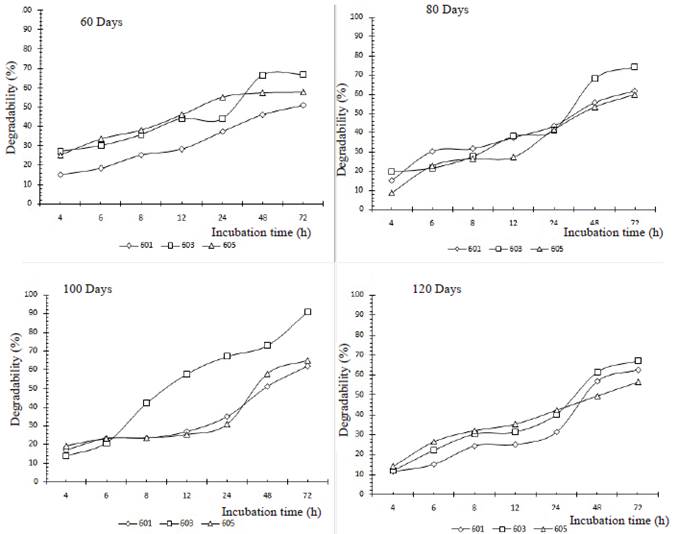The eastern region of Cuba is characterized by highly eroded and saline soils (Benítez et al. 2010), in which the Cauto Valley is located, where 90 % of the region's livestock are developed (Fajardo 2008). The Cauto Valley has semi-arid areas, which includes Granma and Las Tunas provinces, with 48 454 hectares. Granma province represents 50 % of the referred area. Another semi-arid zone is located in Manzanillo municipality, with 16 4215 ha and a third area, corresponding to the southern slope of Sierra Maestra (from the coast up to 500 m o.s.l), from Cabo Cruz to Santiago de Cuba, which covers 63 543 ha. These zones have defined characteristics with rainfalls less than 1000 mm year-1 and long drought periods up to eight months, high evaporation and precipitation/evaporation coefficients lower than 0.45, characteristic of arid zones (Benítez et al. 2010).
Considering these adverse climatic conditions that characterize the Cauto Valley, varieties of Cenchrus purpureus (also known as Pennisetum purpureum) drought tolerant, obtained by in vitro tissue culture of apical portions of Cuba CT-115, were evaluated. These varieties were identified when the characterization of these plants was carried out through the electrophoretic determination of more than five isoenzyme systems, and they were reafirmed by maintaining their initial characteristics for more than five generations (Herrera 2000). The improvement program has been carried out since 2000 and agronomic evaluations have been carried out with favorable results for some varieties, among them CT-601, CT-603 and CT-605, which showed their promisority and superiority with respect to the progenitor (CT- 115). However, evaluations of these plants from the nutritional point of view are still not carried out.
In the specialized bibliography are refers the histochemical modifications that are produced by physiological effect and, in some cases, by external elements, such as climate (Valenciaga 2007, Ramírez 2010 and Verdecia 2015), which influence on the nutritive compounds degradation (Ledea 2016).
The objective of this study is to characterize the in situ ruminal degradability of dry matter and organic matter of drought-tolerant Cenchrus purpureus new varieties under intense seasonal drought conditions, characteristic of Cauto Valley.
Materials and Methods
Location. Determinations of in situ ruminal degradability were developed in the analytical laboratories of the Instituto de Ciencia Animal (ICA), in Mayabeque, Cuba. The samples came from plots established in the Estación Experimental de Pastos y Forrajes, belonging to the Instituto de Investigaciones Agropecuarias "Jorge Dimitrov" ,located in Granma province in Cauto plain, 10 ½ km from Bayamo city, Cuba.
Plant material used. The plant material corresponded to the new varieties of Cenchrus purpureus (CT- 601, CT-603 and CT-605), obtained by tissue culture with drought tolerance, from CT-115.
Experimental procedure. Sampling was carried out in the seed bank, established five years ago in plots of 200 m2. The bank consists of 10 rows, separated at 1 m and 0.75 m between plants. For the establishment of banks, the seeds come from the Department of Grasses and Forages of the Institute of Animal Science, Mayabeque, Cuba. At the moment of taking the samples, in each furrow, the ages to be evaluated were distributed interspersed (60, 80, 100 and 120 d). They were divided by subplots of 4.50 linear m, with four repetitions and one meter of border effect, at the beginning and end of each furrow. Five plants of each regrowth age were taken from each repetition, for a total of four samplings for 60 d, three for 80 and 100 d, and two for 120 d that covered the rainy and dry season. A total 300 g were taken in green base and subjected to drying in a MEMMERT forced air oven at 100 ºC for one hour, and then at 60 ºC until reaching constant weight, according to the methodology proposed by Herrera (2014). Subsequently they were passed through a blade mill to reduce particle size to 2 mm (for degradability) and 1 mm (for the determination of chemical composition). This procedure was performed in each regrowth age.
Chemical composition. The analysis of the samples of new varieties was carried out in the whole plant. The content of dry matter (DM) and crude protein (CP) was determined according to the techniques described by the AOAC (2016) and the neutral detergent fiber (NDF), according to Goering and Van Soest (1970).
In situ ruminal degradability. For the evaluation of in situ ruminal degradability, two Creole cows cannulated in rumen (450 ± 10 kg of live weight) were used, which received grasses forage (Megathyrzus maximum and Cynodon dactylon) ad libitum, with free access to water and mineral salts. A total of 5 g of samples per dacron bag were weighed, after having verified the uniformity of the internal dimensions by means of a millimeter rule, as well as the pore size and the amount of pores.cm2, measured and averaged with the help of a Microscope, model N-800M, with fitted HDCE-50 B camera, Compac computer and Image Driving software.
The bags showed uniform dimensions of 14.0 cm long x 8.5 cm wide internal dimensions, 48 μm porosity and 1044 cm2 pores. They were washed and dried in a BINDER oven at 60 ºC for one hour and then weighed on the SARTORIUS analytical balance of 0.001g precision. The tare was determined for each of the bags included in the experiment. Then they were grouped by regrowth age to introduce them in the rumen, and they were doubled for each sampling hour and animal, for a total of 28 bags in each rod. For ruminal fermentation they were all introduced together and extracted at 0, 4, 6, 8, 12, 24, 48 and 72 h.
Each bag was washed by hand with running water until the water came out transparent, once extracted from the rumen. Subsequently, they were placed in aluminum trays and dried in a BINDER oven at 60 ºC for 72 h. Then they were transferred to a desiccator for 30 min and weighed. The difference between the initial weight of the sample placed in the nylon bags and the weight of the waste after the rumen incubation was used to determine the degraded DM in the rumen. The solubility at zero hour was obtained by incubating two bags with each food in the rumen for 15 min. Then they were treated the same as the rest.
Statistical analysis. The estimation of ruminal degradation was performed through the interactive process of MARQUARDT algorithm, with the help of the procedure for non-linear models, PROC NLIN of the Statgraphics Centurion software version XV.II (Statgraphics 2014). For the estimation of the degradative characteristics, the exponential model proposed by Ørskov and Mc Donald (1979) was used. It was assumed that the degradation curve of the DM over time follows a first-order kinetic process, described as follows:
Where:
P |
- Ruminal degradation. It is the ruminal degradation of the indicator evaluated in the time "t" of permanence in the rumen |
a |
- Intercept (soluble fraction, if time is not limi- ting) |
b |
- Degradable fraction, if time is not limiting (t) |
c |
- Degradation rate of the fraction (b) |
t |
- Incubation time. |
a+b |
- Degradation potential |
A |
- rapidly soluble fraction. |
The rapidly soluble fraction is obtained in several ways. In this study, it was determined by introducing the bag into the rumen, allowing the ruminal fluid to penetrate the bag, and extracting it suddenly after it had completely submerged in the rumen fluid. Then the described procedure for in sacco degradability was continued.
Results and Discussion
Table 1 shows the average chemical composition of the three varieties in the different regrowth ages. There is no high variability in the studied indicators, which are in the range of values reported for the varieties of this genus.
Table 1 Contant of DM, CP and NDF in the whole plant of new varieties of Cenchrus purpureus in different regrowth age

The in situ ruminal degradability of the dry matter (table 2 and figure 1) shows that in the parameters of in situ ruminal degradability of the dry matter of the whole plant, the values for (a) were between 9.07 and 21.67 %, represented by the variety CT-605 and CT-603, respectively. There was high variability during the ages and varieties studied.
Table 2 Characteristics of the in situ ruminal degradability of the dry matter of the whole plant of new drought-tolerant varieties of Cenchrus purpureus at different regrowth age

(a+b): Potential degradation calculated according to model Y=a+b*(1-e^ (-c*t)), a: Soluble fraction, b: Insoluble fraction but potentially degradable, c: Degradation rate, R2: Determination coefficient, SEE: Standard error of estimation

Figure 1 Dynamics of In situ ruminal degradability of dry matter in the whole plant of new varieties of C. purpureus at the ages of 60, 80, 100 and 120 days
The values for this fraction were similar to those referred by Valenciaga et al. (2001) when they evaluated the in situ ruminal degradability of the whole plant of CT-115. This result is understandable, especially if it is taking into account that tropical grasses have a parallel vein pattern that makes them very strong with few weak points for their rupture. The reverse effect benefited Lotus subbiflorus, in a study by Trujillo et al. (2009), who expect to obtain higher degradation values (27.83 %) from the fraction in question.
However, to be a fabaceae it does not differ in a very marked way from the results of the grasses under study, emphatically with the variety CT-603. This shows that, at 60 d, this variety is a food with high contents of soluble carbohydrates, which constitute the easily degradable fraction. Andell et al. (2012) and Ferreira et al. (2014) also obtained results superior to those of this study for this fraction, mainly stimulated by differences between in situ and in vitro techniques (Navarro et al. 2011) and inoculation with microorganisms that modify the ruminal environment, respectively.
Herrera (1997) reported in western Cuba, in cultures that are developed on a typical red ferralitic soil, significant concentrations of soluble compounds in CT-115. These provide, according to Valenciaga (2007) greater benefit on the part of the animal economy, performance that is not in the new varieties, due to the differences that exist between West and East in the type of soil and climate, mainly.
Fraction b had similar performance to the soluble fraction, but ranged from 41.4 to 80.5 %, which varied according to the regrowth age and variety. At the age of 60 d, the lowest values of fraction b were obtained. However, the values at different ages exceeded those obtained by Valenciaga et al. (2001) and Lara et al. (2010), which shows that the structure of the plant and its agronomic performance influenced, above all, in the proportion of leaves. In this sense, Valenciaga et al. (2001) reported that the morphological performance favors the degradability of the DM parameters. Benavidez et al. (2012) alluded to the fact that the anatomical variations influence on the degradation characteristics of the fractions of DM and OM, due to the proportions of the cell type, which determine the amount of digestible fiber, indigestible and totally indigestible, effect that could have influenced on the obtained result.
The potentially degradable fraction showed general degradation values above 50 %, between 53.36 and 90.05 %, which occurred mainly at the ages of 80 and 100 d. However, these high degradation percentages may be related to prolonged retention times in the rumen. In this way, it was observed that the degradation rates as a function of time (c) performed between 1.1 and 13.7% h-1, and coincided with the ages where there was higher degradability of the potentially degradable fraction.
Benavidez et al. (2012), when studying the forage potential of Zea nicaraguensis (Iltis & Benz), obtained values of fractions (b) and (a + b) lower than those obtained in this study. However, the degradation rate was in the ranges mentioned here. Ferreira et al. (2014) also achieved lower values for fraction a + b, which showed degradabilities that coincided with Valenciaga et al. (2001) results, and that were higher to those showed by Ferreira et al. (2014) in whole plants of Cenchrus purpureus. This is in correspondence with the fermentation pattern of the tropical grasses, independently that the Zea nicaraguensis is in another botanical order.
When evaluating the kinetics of DM degradability, peaks from hour 24 were obtained, due to the intervention of other groups of organisms, such as fungi and protozoa that make more rapid use of the substrate (Galindo et al. 2014). In addition, for each age (60, 80, 100 and120 d) an ascend performance was showed up to the last incubation time establish in this experiment.
When the degradation of organic matter was evaluated (table 3, figure 2), variable performance was observed in the degradation parameters. The soluble fraction showed degradation percentages lower than 10% in all ages and varieties contemplated in the study, while fraction (b) did not exceed 50 % degradation. The values of this fraction performed between 37 and 46.2 %. This performance of fractions (a) and (b) predisposed to not reach the potential degradability higher than 50 %.
For the ruminal degradability parameters of organic matter, the values of fraction (a) were decreased. This is associated, according to Lara et al. (2010), to the increase in the passage rate and the decrease in the digestion rate, which causes the fastest outlet of the rumen from undigested organic matter, and causes a tendency to decrease the total microbial yield, as this would increase usually if the amount of fermented organic matter is higher.
The fraction (a + b) and the ruminal passage rate (c) (3.3 and 7.3 % h-1) were lower only for Tithonia diversifolia, of the nine shrubs assessed by Naranjo and Cuartas (2011). This shows that the new varieties have potentialities such as shrub legumes, regardless of the difference of genus and species, among which the nutritional value for the cultivars of C. purpureus highlight. However, they do not have in a majority way, cells with a developed secondary cell wall, and primary walls seriously compromised by structural compounds (table 3). Cáceres (1985) reported that the organic matter digestibility depends on the proportions of the cell walls and their digestibility, as well as on the proportion of membranes with presence of lignin and indigestible compounds or of poorly degradability, factors which are in the cultivars under study, and in which it is necessary to deepen future studies on their impact on the degradability, according to the molecular structure.
In the dynamics of ruminal degradability (figure 2), it was observed that until the 12th hour of incubation the ascending performance was discrete. According to Galindo et al. (2014), this is because the bacteria, which are the first to colonize and begin to degrade the substrate, do not have the enzymes that can degrade the great diversity of connectors and interconnectors, intramolecular and intermolecular, that present structural carbohydrates. However, from the 24th hour, there is evidence of increase and a marked phase shift of the degradative kinetics, favored by the CT-603 variety. Therefore, the CT-601 and CT-605 uniformly continued the degradability curve.
Tabla 3 Characteristics of the in situ ruminal degradability of the organic matter of the whole plant new drought - tolerant varieties of Cenchrus purpureus at different regrowth age


Figure 2 Dynamics of in situ ruminal degradability of organic matter in the whole plant of new varieties of C. purpureus at the ages of 60, 80, 100 and 120 days of regrowth.
This is due to the incorporation of other microorganisms to the degradation of structural compounds that enhanced bacterial action. According to Pedraza (2014), this capacity is only attributed to a group of ligninolitic fungi, which secrete peroxidases (extracellular, non-specific), capable of degrading the compounds that represent the lignin structures. Therefore, with respect to the rest of the varieties under study, the CT-601 variety shows a higher quantity of structures that are part of the dry matter.
By the age of 80 d, the performance begins to change, becoming more ascending, due to the higher availability of substrate on which to act. Valenciaga (2007), Ramírez (2010) and Fortes (2014) reported that these histochemical modifications affect the substrate-enzyme relation due to the thickening of cell walls and the increase in structural carbohydrates with increasing age. Valenciaga (2007) described that the characteristics of the substrate (chemical composition and anatomical structure) is a factor that determines the microbial action, where it was appreciated that the ruminal microflora was not affected when causing degradations higher than 50 %.
In general, the gradation kinetics shows the fermentation pattern of tropical grasses, where complex chemical transformations limit the use of plant material below 50 % (Cáceres 1985).
It is concluded that the in situ ruminal degradability of the DM and OM of the whole plant of the Cenchrus purpureus new varieties maintains the ruminal fermentation pattern of the tropical grasses.











 text in
text in 



